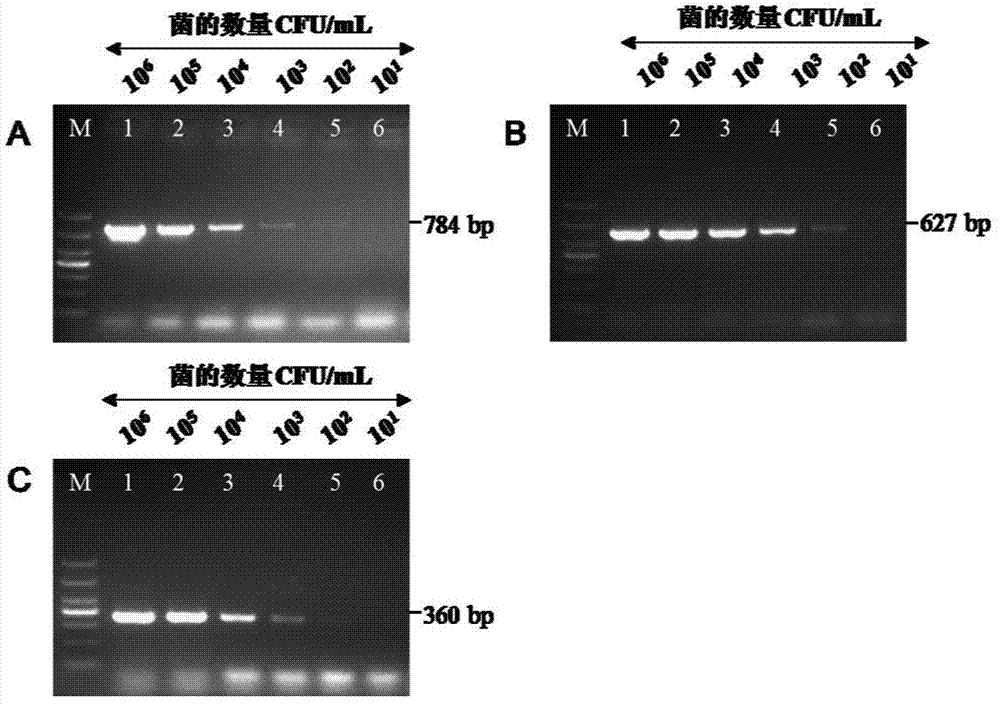Method for simultaneously detecting salmonella typhimurium, escherichia coli O157:H7 and listeria monocytogenesis
A technology for Listeria and Salmonella, applied in biochemical equipment and methods, microbe measurement/inspection, and resistance to vector-borne diseases, can solve problems such as low specificity, low accuracy, and complex influencing factors, and achieve The effect of simple result judgment, reduced detection cost, and improved sensitivity
- Summary
- Abstract
- Description
- Claims
- Application Information
AI Technical Summary
Problems solved by technology
Method used
Image
Examples
Embodiment 1
[0043] Example 1, Preparation and Purification of Polyclonal Antibody
[0044] 1.1 Preparation of bacteria for immunization
[0045] LB solid plate was streaked to activate Salmonella typhimurium and Escherichia coli O157:H7, pick a single colony and carry out shaking culture in LB liquid at 37℃; Shake culture. Collect bacteria by centrifugation at 4000g for 5 minutes; resuspend and wash the bacteria twice in PBS, and finally resuspend them in PBS and perform ultrasonic crushing; centrifuge at 13000g and 10 minutes to enrich the bacteria fragments, resuspend in PBS, wash twice, and resuspend ; Add formalin solution (37% formaldehyde) at 0.7:100, mix well, place at room temperature, and inactivate the bacteria for 24 hours; centrifuge at 13000g for 10 minutes, take the precipitate, wash it twice with PBS (to remove formaldehyde); collect by centrifugation Precipitate, store at -80°C for future use (you can weigh it first and divide it into equipment).
[0046] 1.2 Preparatio...
Embodiment 2
[0049] Embodiment 2, the preparation of immunomagnetic beads
[0050] 2.1 Accurately prepare 1mg / mL BSA solution with 0.005M borate buffer.
[0051] 2.2 Take 5 mg of magnetic beads and wash them once with ethanol (to remove the surfactant).
[0052] 2.3 Wash twice with sterile MEST (pH5.5~6.0), remove the supernatant after magnetic separation.
[0053] 2.4 Add EDC / NHSS (each 5 mg) and shake to activate at room temperature for 30 minutes.
[0054] 2.5 Remove the supernatant after magnetic separation, resuspend with sterile MEST (pH5.5~6.0), transfer to a new centrifuge tube, and wash three times.
[0055] 2.6 Take a 1.5mL centrifuge tube, add 100μL 1mg / mL purified polyclonal antibody, make up to 1mL with 0.005M borate buffer, adjust the pH to 8.5~9.0 with NaOH, quickly add to the freshly activated magnetic beads and shake at room temperature Reaction 3h.
[0056] 2.7 After magnetic separation, the supernatant was aspirated, and the magnetic beads coupled to the antibody wer...
Embodiment 3
[0057] Embodiment 3, sample pretreatment
[0058] Let us take a food sample as an example to illustrate the process of sample processing in the method of the present invention.
[0059] Weigh 1g of food sample, add 9mL of PBS, grind to make a homogenate, centrifuge at 900g for 5min, remove the enlarged food residue, and take the supernatant (this process must be performed aseptically).
[0060] Step 4. Immunomagnetic beads capture target bacteria in food samples
[0061] Take 1 mL of food sample liquid, add 2.0 mg of immunomagnetic beads, incubate with gentle shaking at 37°C for 45 min, separate with a magnetic frame, wash twice with PBST, and resuspend the separated magnetic beads in 50 μL of PBS.
PUM
 Login to View More
Login to View More Abstract
Description
Claims
Application Information
 Login to View More
Login to View More - R&D
- Intellectual Property
- Life Sciences
- Materials
- Tech Scout
- Unparalleled Data Quality
- Higher Quality Content
- 60% Fewer Hallucinations
Browse by: Latest US Patents, China's latest patents, Technical Efficacy Thesaurus, Application Domain, Technology Topic, Popular Technical Reports.
© 2025 PatSnap. All rights reserved.Legal|Privacy policy|Modern Slavery Act Transparency Statement|Sitemap|About US| Contact US: help@patsnap.com



